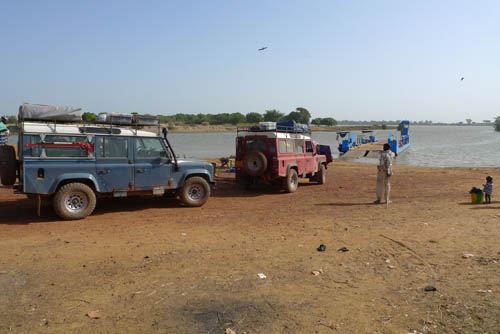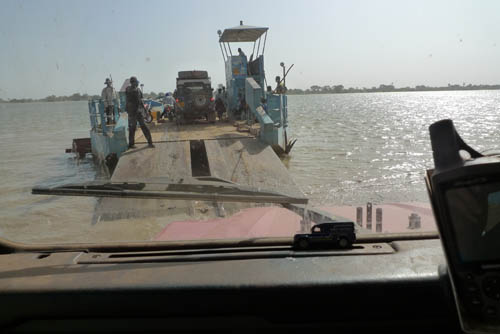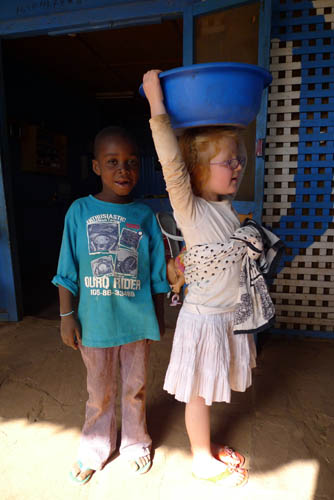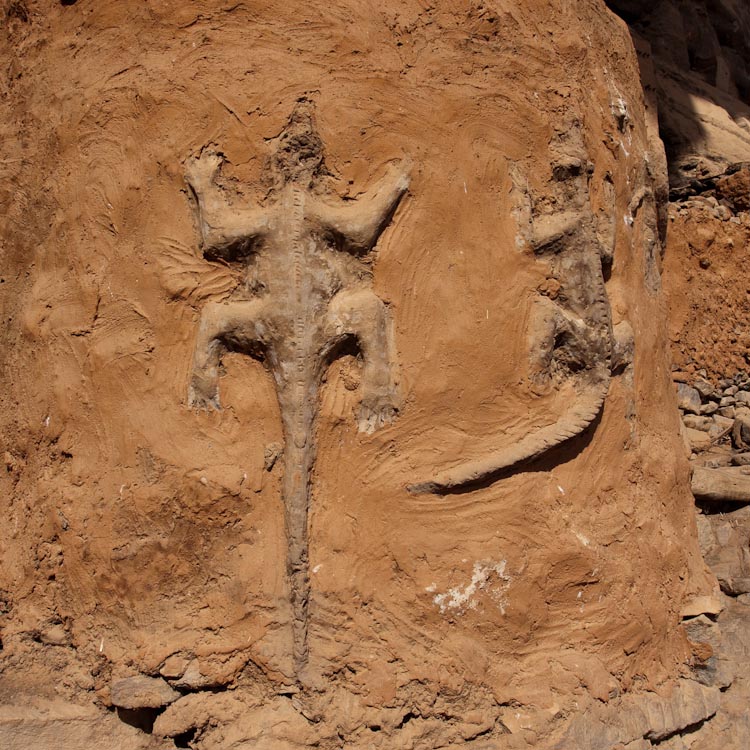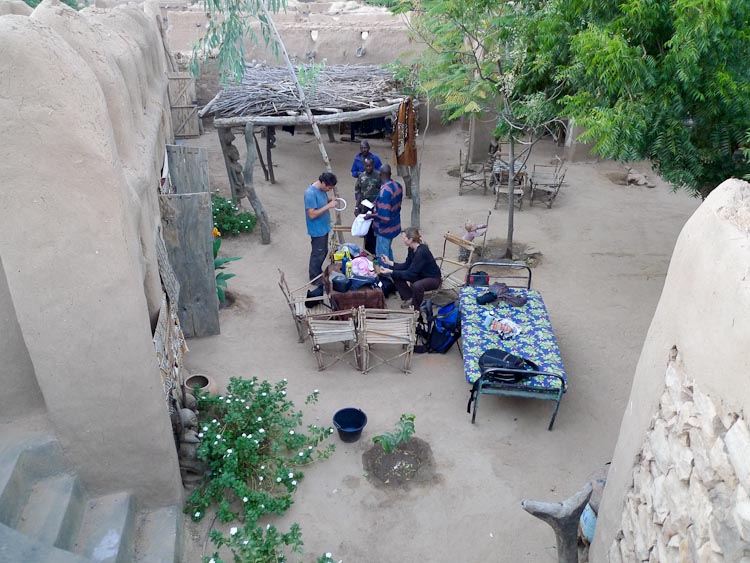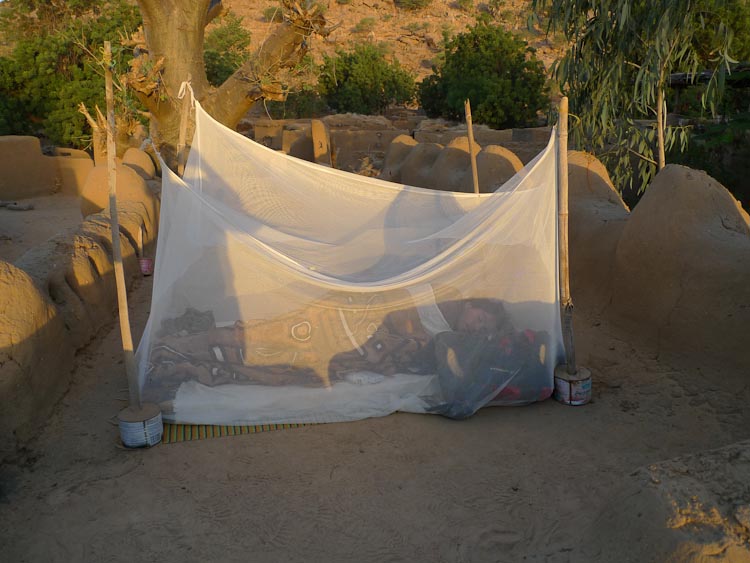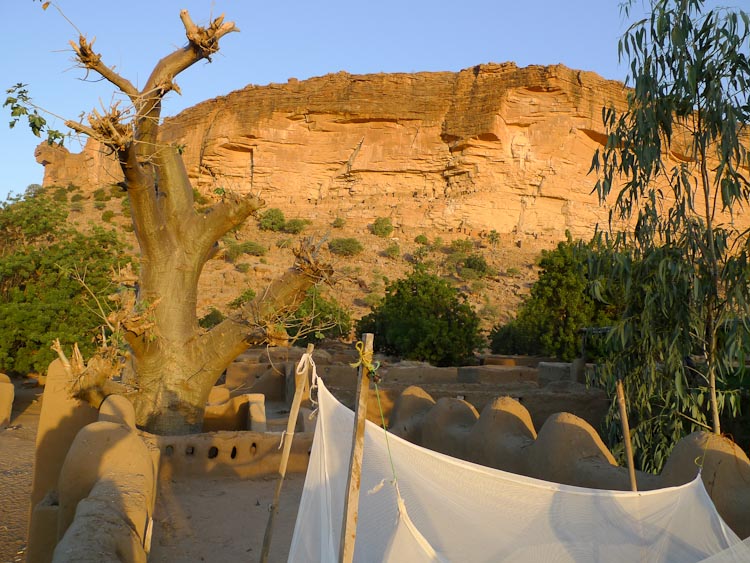Mali - Dogon country
Day 65 (9 December) – Driving to Bandiagara
Day 65 and we broke our first record! Leaving Djenne we follow a dirt road over a very narrow bridge to leave the island and then discover to get any further we need to take a ferry! There are small ferrys going back and forth and it is a short wait, a small fee and a mad dash to make it on board! A 10 minute crossing and we continue on the dirt track on the other side. We are surrounded by wetlands. It is the first view of grass – fields of grass – in a long time. We pass men wearing long robes and Tuareg hats, women are gathered in groups under trees pounding millet and sorghum.
We arrive in Bandiagara and head to Le Fraternite – a restaurant in town – for some lunch and to sort out a guide for a hike into Dogon Country. Eowyn has an age mate there – Emmanuel – and they become fast friends and play all afternoon while we eat a fantastic meal, chat and get a guide. Eowyn has her baby strapped on her back and grabs a washbasin and puts it on her heat – playing house African village style!
While Niels and Julia look for an appropriate guide, the others remain in the restaurant and Senna soon joins into playing with Emmanuel and Eowyn. They find a huge washbasin filled with water and given the heat this was ideal for some splashing. Not long after initiating Stanley sees 2 small legs up in the air on the basin edge and runs towards it: Senna had managed to balance on the bucket with her head in the water and she was fine but stunned, though only for a second as she immediately returned to the basin.
Day 66 (10 December) – Dogon country
Before leaving town we buy a bag of Kola nuts to hand out as thanks and greetings. We give them to our guide who hands them out as we walk along. They are only eaten by adults and turn your teeth a redish color. We tried a bite and they are bitter and sort of dry the mouth out – not my favorite. But they are a sign of thanks and friendship and people in Dogon seem to LOVE them.
We stop along the road on our way to Djiguibombo. They are growing green onions, tomato, carrot, lettuce and chili peppers – very different from East Africa where everything is cooked within an inch of its life – here they eat salad!! Traditionally, water was brought onto the small plots in a calabash. The plots we are looking at have a pump to bring water just up from the small stream below (we do see people hauling water with calabashes later on). The farm plots are small and subdivided into small pockets to hold the water in. Before we leave we say thanks (“Ghana” and you are welcome “Ghana Bani”) and give Kola nuts to the older farmers.
Djiguibombo:
Again, it is a change in architecture. There are small, round mud graneries and houses with tall pointed thatch roofs. The graneries are built on rocks (to keep them safe from water). Some of the columns supporting the roof are Y shaped and carved for decoration. Doors and windows are of carved wood – a beautiful accompaniment to the plain mud buildings. Before we begin the walk through town it is time to feed Senna. There is a large audience of kids and each time Julia drop a morsel there is a round of ‘awwwwww’ as if a free kick to win the game was missed. The man selling souvenirs has been trying to get my attention but with all the kids hasn’t been able to get through. Solution? Pick up a stick – ever present especially in a rural environment. Just raising it sends the kids scattering but for effect he smacks one of them on the top of the head anyway.
In Djiguibombo we see the togu-na - the Dogon Hall of Justice. If any man has a problem it is brought to the togu-na and then discussed by the elders and a decision handed down by the chief. The women bring their problems to the well where they go daily for water. If Julia has a problem with Stanley she would go to the well and tell an older woman (while presumably all other women are listening) and Stanley would go to the togu-na to tell all the men – there aren’t any personal secrets in these villages!!
We leave the cars in Kani-Kombole and walk 3km to Teli where we take a break and have lunch of rice and vegetables. After lunch we hike up to the abandoned (but preserved) village built into the escarpment.
We spend the night in Ende. Before dinner (but after it is already dark) we want to take a small walk around the neighbourhood. Our guide warns us not to touch anything and be very careful as there are a lot of sacred sites that are not obvious to an outsider. We don’t actually go very far after that!! Dinner is sweet potato in sauce, green beans, stewed chicken and bread.
Eowyn finds again some local friends and as they cannot communicate in words they start imitating different animals. With Eowyn taking the lead, all other kids start crawling through the dirt, all loving it. Unfortunately, Senna isn’t feeling well and has a difficult time falling asleep and staying asleep.
Day 67 (11 December) – Dogon country
The next morning we are up early (even earlier than usual). Eowyn wants to make sure Niels is up and goes up to the roof where he is sleeping under a mosquito net on a mat. The village chief who is somehow affiliated with the campement is up and eager to show us some souvenirs at 6am!! We wander out back of the campement and quickly lose interest in his pitch as we see a woman making poffertjes! Sort of. She has a cast iron ‘table’ which stands over an open fire and has divits for the small pancakes to cook. They are made from millet flour and oil and with a bit of sugar Eowyn finishes one portion and has to go back for seconds.
After some serious Africa negotiations (about 5 separate discussions), Stanley and Julia buy a Tellem doorlock made out of bronze. The Tellem were Pygmies living in tiny huts way high on the escarpment at totally inaccessible places, but left the escarpment some 100 years ago.
On our walk through Ende we stop at a small ‘house’ where a local hunter gets up and puts on all his hunting garb (a creepy burlap shirt with skulls sewn into it and a matching hat, his gun, etc) and offers to let us take his picture for a fee. We politely declined - we were more interested in the burqua Barbie backpack lying on the bench. I wish I had a picture of that!


